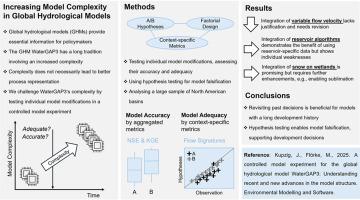全球水文模型WaterGAP3的控制模型实验:了解模型结构的最新进展
IF 4.6
2区 环境科学与生态学
Q1 COMPUTER SCIENCE, INTERDISCIPLINARY APPLICATIONS
引用次数: 0
摘要
全球水文模型WaterGAP3有着悠久的传统,其复杂性也随之增加。本研究首次进行了模型实验,以测试这种增加的复杂性是否会在三个单独的模型部分中导致更好的过程表示。首先,我们的大样本分析结果表明,最近实施的基于体积的河流路线在大约2/3的流域中没有产生更好的过程代表性,缺乏合理性。其次,油藏算法证明了使用油藏特定数据的优势。然而,这些方法显示出个别的弱点,表明需要未来的发展。第三,在湿地上实施积雪过程是有希望的。然而,未来的工作需要使升华和解决在冬季期间高估的放电。总体而言,本研究表明,回顾过去的决策对科学进步至关重要,并通过大样本分析显示了模型证伪的有效性。本文章由计算机程序翻译,如有差异,请以英文原文为准。

A controlled model experiment for the global hydrological model WaterGAP3: Understanding recent and new advances in the model structure
The global hydrological model WaterGAP3 has a long tradition that involves increased complexity. For the first time, this study conducts a model experiment to test whether this increased complexity leads to better process representation in three individual model parts. First, the findings of our large-sample analysis reveal that the recently implemented volume-dependent river routing does not produce better process representation in about 2/3 of the basins, lacking justification. Second, the reservoir algorithms demonstrate the benefit of using reservoir-specific data. However, the approaches show individual weaknesses, indicating the need for future development. Third, implementing snow processes on wetlands is promising. However, future work is needed to enable sublimation and to address overestimated discharges during winter periods. Overall, this study demonstrates that revisiting past decisions is essential for scientific progress and shows the efficacy of model falsification through large-sample analysis.
求助全文
通过发布文献求助,成功后即可免费获取论文全文。
去求助
来源期刊

Environmental Modelling & Software
工程技术-工程:环境
CiteScore
9.30
自引率
8.20%
发文量
241
审稿时长
60 days
期刊介绍:
Environmental Modelling & Software publishes contributions, in the form of research articles, reviews and short communications, on recent advances in environmental modelling and/or software. The aim is to improve our capacity to represent, understand, predict or manage the behaviour of environmental systems at all practical scales, and to communicate those improvements to a wide scientific and professional audience.
 求助内容:
求助内容: 应助结果提醒方式:
应助结果提醒方式:


